Fuller Margaret
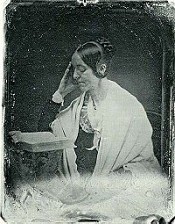
Sarah Margaret Fuller Ossoli, more commonly known as Margaret Fuller, (May 23, 1810 – July 19, 1850) was a journalist, critic and women's rights activist associated with the American transcendental movement. She was the first full-time female book reviewer in journalism. Her book Woman in the Nineteenth Century is considered the first major feminist work in the United States. Born Sarah Margaret Fuller in an area of Cambridge, Massachusetts, she was given a substantial early education by her father, Timothy Fuller. She later had more formal schooling and became a teacher before, in 1839, she began overseeing what she called "conversations": discussions among women meant to compensate for their lack of access to higher education. She became the first editor of the transcendental publication The Dial in 1840 before joining the staff of the New York Tribune under Horace Greeley in 1844. By the time she was in her 30s, Fuller had earned a reputation as the best-read person in New England, male or female, and became the first woman allowed to use the library at Harvard College. Her seminal work, Woman in the Nineteenth Century, was published in 1845. A year later, she was sent to Europe for the Tribune as its first female correspondent. She soon became involved with the revolution in Italy and allied herself with Giuseppe Mazzini. She also met Giovanni Ossoli, with whom she had a child. All three members of the family died in a shipwreck off Fire Island, New York, traveling back to the United States in 1850. Fuller's body was never recovered. Fuller was an advocate of women's rights and, in particular, women's education and the right to employment. She also encouraged many other reforms in society, including prison reform and the emancipation of slaves in the United States. Many other advocates for women's rights and feminism, including Susan B. Anthony, cite Fuller as a source of inspiration. Many of her contemporaries, however, were not supportive, including her former friend Harriet Martineau, who said that Fuller was a talker rather than an activist. Shortly after Fuller's death her importance faded; the editors who prepared her letters to be published, believing her fame would be short-lived, were not concerned about accuracy and censored or altered much of her words before publication. Sarah Margaret Fuller was born May 23, 1810,[1] in Cambridgeport, Massachusetts, the first child of Timothy Fuller and Margaret Crane Fuller. She was named after her paternal grandmother and her mother; by the age of nine, however, she dropped "Sarah" and insisted on being called "Margaret".[2] The Margaret Fuller House, in which she was born, is still standing. Her father taught Fuller to read and write at the age of three and a half, shortly after the couple's second daughter, Julia Adelaide, had died at the age of fourteen months.[3] He offered her an education as rigorous as any boy's at the time and forbade her from reading the typical feminine fare such as etiquette books and sentimental novels.[4] He incorporated Latin into his teaching shortly after the birth of the couple's son, Eugene, in May 1815, and soon she was translating simple passages from Virgil.[5] During the day, young Margaret spent time with her mother, who taught her household chores and sewing.[6] In 1817, her brother William Henry Fuller was born and her father was elected as a representative in the United States Congress. For the next eight years, he would spend four to six months of the year in Washington, D.C.[7] At the age of 10, Fuller wrote a cryptic note which her father saved: "On the 23rd of May, 1810, was born one foredoomed to sorrow and pain, and like others to have misfortunes".[8] In 1824, Fuller was sent to the School for Young Ladies in Groton at the advice of aunts and uncles, though she resisted the idea at first.[9] While she was in Groton, Timothy Fuller, in order to help John Quincy Adams with his presidential campaign in 1824, did not run for re-election; he had hoped Adams would return the favor with some kind of government appointment.[10] On June 17, 1825, Fuller was in attendance at the ceremony when the American Revolutionary War hero Marquis de Lafayette laid the cornerstone of the Bunker Hill Monument 50 years after the battle.[11] Fuller left the Groton school and returned home at the age of 16 after having studied there for two years.[12] At home, she studied the classics and trained herself in several modern languages and various examples of world literature.[13] By this time, she realized she did not fit in with other young women her age. She wrote, "I have felt that I was not born to the common womanly lot".[14] Eliza Farrar, wife of Harvard professor John Farrar and author of The Young Lady's Friend (1836), attempted to train her in feminine etiquette until the age of 20,[15] though Farrar was never wholly successful.[16] Fuller was an avid reader; by the time she was in her 30s, she had earned a reputation as the best-read person, male or female, in New England.[17] She used her knowledge to give private lessons based on the teaching style of Elizabeth Palmer Peabody.[18] Fuller hoped to earn her living through journalism and translation; her first published work, a response to historian George Bancroft, appeared in November 1834 in the North American Review.[19] When she was 23, her father's law practice failed and he moved the family to a farm in Groton.[20] On February 20, 1835, both Frederick Henry Hedge and James Freeman Clarke requested written contributions from her to publish in their respective periodicals. Clarke helped her publish her first literary review in the Western Messenger in June: criticisms of recent biographies on George Crabbe and Hannah More.[21] In the fall of that year, she suffered a terrible migraine with a fever that lasted nine days; Fuller would often be plagued with headaches throughout her life.[22] While she was still recovering, her father died of cholera on October 2, 1835.[23] She was deeply affected by his death: "My father's image follows me constantly", she wrote.[24] She vowed to step in as the head of the family and take care of her newly widowed mother and her younger siblings.[25] Her father had not left a will, and two of her uncles gained control of his property and finances, later assessed at $18,098.15, and forced the family to rely on them for support. Humiliated by the way her uncles were treating the family, Fuller wrote that she regretted being "of the softer sex, and never more than now".[26] Around this time, Fuller had hoped to prepare a biography of Johann Wolfgang von Goethe, but felt that she could work on it only if she traveled to Europe. Her father's death and her sudden responsibility over her family caused her to abandon this idea.[19] In 1836, Fuller was given a job teaching at Bronson Alcott's Temple School in Boston,[27] where she remained for a year. She then accepted an invitation to teach at the Greene Street School in Providence, Rhode Island, in April 1837 with the unusually high salary of $1,000 per year.[28] Her family sold the Groton farm and Fuller moved with them to Jamaica Plain, Massachusetts.[29] On November 6, 1839, Fuller held the first of her "conversations",[30] discussions among local women who met in the Boston home of the Peabodys.[31] Fuller intended these meetings to compensate for the lack of education for women[32] with discussions and debates which focused on subjects including the fine arts, history, mythology, literature, and nature.[33] Serving as the "nucleus of conversation", Fuller also intended to answer the "great questions" facing women: "What were we born to do? How shall we do it? which so few ever propose to themselves 'till their best years are gone by".[34] A number of significant figures in the women's rights movement attended these "conversations", including Sophia Dana Ripley, Caroline Sturgis,[35] and Maria White Lowell.[30] In October 1839, Ralph Waldo Emerson was seeking an editor for his transcendental journal The Dial and, after several had declined the role, he offered it to Fuller, referring to her as "my vivacious friend".[36] Emerson had first met Fuller in Cambridge in 1835; of that meeting, he admitted "she made me laugh more than I liked". The next summer, Fuller spent two weeks at Emerson's home in Concord where their friendship grew.[37] Fuller accepted Emerson's offer to edit The Dial on October 20, 1839, though she did not begin work until the first week of 1840.[38] She edited the journal for the first two years of its existence from 1840 to 1842, though her promised annual salary of $200 was never paid.[39] Because of her role, she was soon recognized as one of the most important figures of the transcendental movement and was invited to George Ripley's Brook Farm communal experiment.[40] She never officially joined the community but was a frequent visitor, often spending New Year's Eve there.[41] In the summer of 1843, she traveled to Chicago, Milwaukee, Niagara Falls and Buffalo, New York;[42] while there, she interacted with several Native Americans, including members of the Ottawa tribe and the Chippewa tribe.[43] She reported her experiences in a book called Summer on the Lakes,[42] which she completed writing on her 34th birthday in 1844;[44] critic Evert Augustus Duyckinck called it "the only genuine book, I can think of, this season".[45] She had used the library at Harvard College for further background information on the Great Lakes region,[42] making her the first woman allowed to use Harvard's library.[46] One of Fuller's most important works, "The Great Lawsuit", was written in serial form for The Dial. She originally intended to name the work "The Great Lawsuit: Man versus Men, Woman versus Women";[47] when it was expanded and published independently in 1845, it was instead named Woman in the Nineteenth Century. After completing it, she wrote to a friend: "I had put a good deal of my true self in it, as if, I suppose I went away now, the measure of my footprint would be left on earth."[48] The work discussed the role that women played in the American democracy and Fuller's opinion on possibilities for improvement. It has since become one of the major documents in American feminism[49] and is considered the first of its kind in the United States.[48][50]
do you like this author?
What readers are saying
What do you think? Write your own comment on this book!
write a commentWhat readers are saying
What do you think? Write your own comment on this author!
write a commentBook list

Life Without and Life Withinor,Reviews,Narratives,Essays,and poems.
Series:
Unknown
Year:
Unknown
Raiting:
3.5/5
Show more
add to favoritesadd In favorites

At Home And AbroadOr,Things And Thoughts In America and Europe
Series:
Unknown
Year:
Unknown
Raiting:
3/5
Show more
add to favoritesadd In favorites

Woman in the Ninteenth Centuryand Kindred Papers Relating to the Sphere,Conditionand Duties,of Woman.
Series:
Unknown
Year:
Unknown
Raiting:
2.5/5
Show more
add to favoritesadd In favorites
Book list

Life Without and Life Withinor,Reviews,Narratives,Essays,and poems.
Series:
Unknown
Year:
Unknown
Raiting:
3.5/5
Show more
add to favoritesadd In favorites

At Home And AbroadOr,Things And Thoughts In America and Europe
Series:
Unknown
Year:
Unknown
Raiting:
3/5
Show more
add to favoritesadd In favorites

Woman in the Ninteenth Centuryand Kindred Papers Relating to the Sphere,Conditionand Duties,of Woman.
Series:
Unknown
Year:
Unknown
Raiting:
2.5/5
Show more
add to favoritesadd In favorites

woman in the nineteenth century and kindred papers relating to the sphere con
Series:
Unknown
Year:
Unknown
Raiting:
4/5
This scarce antiquarian book is included in our special Legacy Reprint Series. In the interest of creating a more extensive selection of rare historical book reprints, we have chosen to reproduce this title even though it may possibly have occasional imperfections such as missing and blurred pages, missing text, poor pictures, markings, dark backgrounds and other reproduction issues beyond our control. Because this work is culturally important, we have made it available as a part of our commitment to protecting, preserving and promoting the world's literature. --This text refers to the Paperback edition.
Show more
add to favoritesadd In favorites

papers on literature and art
Series:
Unknown
Year:
Unknown
Raiting:
2.5/5
Purchase of this book includes free trial access to www.million-books.com where you can read more than a million books for free. This is an OCR edition with typos. Excerpt from book: THE PROSE WORKS OF MILTON. WITH A BIOGRAPHICAL INTRODUCTION, BY K. W. GRISWOLD. The noble lines of Wordsworth, quoted by Mr. Griswold on his title-page, would be the best and a sufficient advertisement of each reprint: " Milton! thou shouldst be living at this hour. Return to us again, And give us manners, virtue, freedom, power. Thy soul was like a Star, and dwelt apart; Thou hadst a voice whose sound was like the Sea: Pure as the naked Heavens, majestic, free: So didst thou travel on life's common way In cheerful Godliness, and yet thy heart The lowliest duties on .herself did lay." One should have climbed to as high a point as Wordsworth to be able to review Milton, or even to view in part his high places. From the hill-top we still strain our eyes looking up to the mountain-peak "Itself Earth's Rosy Star." We rejoice to see that there is again a call for an edition of Milton's Prose Works. There could not be a surer sign that there is still pure blood in the nation than a call for these. The print and paper are tolerably good ; if not worthy of the matter, yet they are, we suppose, as good as can be afforded and make the book cheap enough for general circulation. We wish therehad been three volumes, instead of two clumsy ones, with that detestably narrow inner margin of which we have heretofore complained. But we trust the work is in such a shape that it will lie on the table of all poor students who are ever to be scholars, and be the good angel, the Ithuriel warner of many a youth at the parting of the ways. Who chooses that way which the feet of Milton never forsook, will find in him a never failing authority for the indissoluble union between permanent strength and purity. May many, born and bred amid the corruptions of a false world till the hear...
Show more
add to favoritesadd In favorites

love letters of margaret fuller 1845 1846
Series:
Unknown
Year:
Unknown
Raiting:
4.5/5
To Which Are Added The Reminiscences Of Ralph Waldo Emerson, Horace Greeley And Charles T. Congdon. This scarce antiquarian book is included in our special Legacy Reprint Series. In the interest of creating a more extensive selection of rare historical book reprints, we have chosen to reproduce this title even though it may possibly have occasional imperfections such as missing and blurred pages, missing text, poor pictures, markings, dark backgrounds and other reproduction issues beyond our control. Because this work is culturally important, we have made it available as a part of our commitment to protecting, preserving and promoting the world's literature. --This text refers to the Paperback edition.
Show more
add to favoritesadd In favorites

life without and life within or reviews narratives essays and poems
Series:
Unknown
Year:
Unknown
Raiting:
2.5/5
Show more
add to favoritesadd In favorites

art literature and the drama
Series:
Unknown
Year:
Unknown
Raiting:
2.5/5
Originally published in 1889. This volume from the Cornell University Library's print collections was scanned on an APT BookScan and converted to JPG 2000 format by Kirtas Technologies. All titles scanned cover to cover and pages may include marks notations and other marginalia present in the original volume.
Show more
add to favoritesadd In favorites
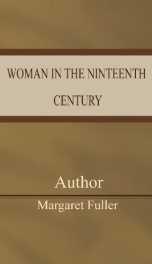
Woman in the Ninteenth Century
Series:
Unknown
Year:
Unknown
Raiting:
3.5/5
Product DescriptionIn this enormously influential book, published in 1845, the prototypical feminist writer of her day addressed a wide range of issues, from the Woman Question to prostitution and slavery, marriage and employment reform, and the European revolutionary movements of the 1840s. A thought-provoking challenge to contemporary assumptions of male privilege, Woman in the Nineteenth Century is today a classic of feminist literature.About the AuthorLarry J. Reynolds is Thomas Franklin Mayo Professor in Liberal Arts and Professor of English at Texas A&M University, where he co-founded and served as first director of the Interdisciplinary Group for Historical Literary Study. He is author of James Kirke Paulding and European Revolutions and the American Literary Renaissance and co-editor of "These Sad But Glorious Days": Dispatches from Europe, 1846–1850 and New Historical Literary Study.
Show more
add to favoritesadd In favorites

Summer on the Lakes, in 1843
Series:
Unknown
Year:
Unknown
Raiting:
2/5
Summer on the Lakes, in 1843 includes the memories of a famous American writer Margaret Fuller who traveled to the Midwest and spent some time there. This book describes her trip in Chicago, Milwaukee, Michigan and Wisconsin. Margaret visits some of her good friends and also meet new people and when observing their way of living in the rural areas, she compares it to the life of people in cities. The description of the local culture is also incuded in the book. A great section of the story provides information about American Indians, their culture and problems they faced. The book is definitely recommended for everyone who is interested in the history of the region.
Show more
add to favoritesadd In favorites
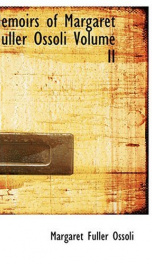
Memoirs of Margaret Fuller Ossoli, Volume II
Series:
Unknown
Year:
Unknown
Raiting:
5/5
The earliest recollection of Margaret is as a schoolmate of my sisters in Boston.
Show more
add to favoritesadd In favorites
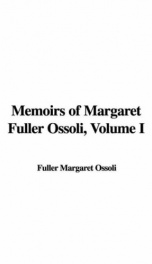
Memoirs of Margaret Fuller Ossoli, Volume I
Series:
Unknown
Year:
Unknown
Raiting:
5/5
Thus passed my first years. My mother was in delicate health and much absorbed in the care of her younger children. In the house was neither dog nor bird nor any graceful animated form of existence.
Show more
add to favoritesadd In favorites
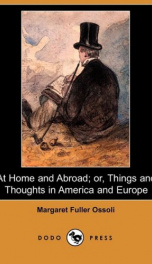
At Home And Abroad
Series:
Unknown
Year:
Unknown
Raiting:
3/5
Sarah Margaret nee Fuller Ossoli (1810-1850) was a journalist, critic and women's rights activist. She was the first full-time female book reviewer in journalism, becoming the first editor of the Transcendental publication The Dial in 1840 before joining the staff of the New York Tribune in 1844. She was sent to Europe in 1846 by the Tribune, specifically England and Italy, as its first female foreign correspondent. Her book Woman in the Nineteenth Century (1845) is considered the first major feminist work in the United States. It began as an essay, The Great Lawsuit, written in serial form for The Dial. Ossoli was an advocate of women's rights and, in particular, women's education and the right to employment. She also encouraged many other reforms in society, including prison reform and the emancipation of slaves in the United States. Soon after her death, many of her writings were collected and published. In 1852, Memoirs of Margaret Fuller Ossoli was published, though much of the work was censored or reworded. Her brother Arthur also later published At Home and Abroad (1856) and Life Without and Life Within (1858).
Show more
add to favoritesadd In favorites
What readers are saying
What do you think? Write your own comment on this author!
write a commentif you like Fuller Margaret try:
readers also enjoyed
What readers are saying
What do you think? Write your own comment on this author!
write a commentGenre
if you like Fuller Margaret try:
readers also enjoyed
Do you want to exchange books? It’s EASY!
Get registered and find other users who want to give their favourite books to good hands!

